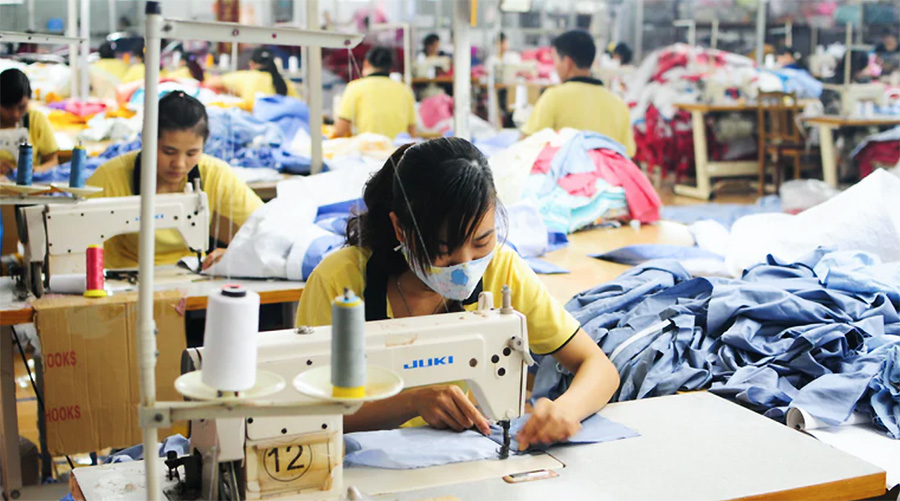Economists at BofA Global Research, in a new report, found that while production disruptions in Vietnam have eased, a return to full capacity by the end of 2021, especially in the labor-intensive apparel and footwear sectors, could be overly optimistic.
On the positive side, Mohamed Faiz Nagutha, ASEAN Economist at Bank of America Merrill Lynch (BofA), wrote in a report that following the surge in COVID cases in July and August that led the Vietnamese government to implement strict lockdowns and mandated factory closures, the country made notable progress in vaccination rates and, since September, restrictions have started to ease. However, Nagutha believes predictions from global sports brands and their OEMs (original equipment manufacturers) that factories in Vietnam will reach full capacity by December could be challenging to meet.
“While production activities indeed recovered fast last year after the brief COVID-related disruption, production is likely to take longer to normalize this time around, perhaps as long as six months,” said Nagutha. “While the catch-up pace could be relatively fast at the beginning, we believe it will get more difficult to close the final 10-to-20 percent of the capacity gap if labor shortages persist.”
He cited four reasons for the slower return to normalized production in Vietnam:
- Sluggish recovery: The COVID outbreak was concentrated in southern Vietnam, where most of the footwear and a significant share of apparel production occurred. Google data indicates that transit and workplace mobility are still down 60 percent in the Southern region in the latter part of October, much worse than mobility in Northern Vietnam. Nagutha wrote, “We believe this sluggish recovery of mobility in the South is indicative of the differences in restrictions and also the lasting effects of the outbreak. The gap is too large and will take months to close in our view.”
- Return to employment complicated: Provinces in Vietnam enforce different rules for mobility, work and travel, which have complicated the return to employment for many migrant workers. For instance, Ho Chi Minh City (HCMC), southern Vietnam’s commercial capital, has mandated at least one dose of the coronavirus vaccine and a health app for movement within the city, while northern cities in the region have fewer restrictions. The factory guidelines are also complicated and restrict many vaccinated workers in southern factories from returning to their homes.
- Full vaccination rates among the lowest in the region: Despite substantial progress over the last few months, Vietnam’s full vaccination rate is only around 30 percent, among the lowest in the ASEAN region. Naturally-acquired immunity is also likely to be weak given that only one percent of the population are confirmed as COVID-positive cases to date. At the current pace, around 70 percent of Vietnam’s population will be fully vaccinated by January 2022 and 80 percent by Februrary 2022. The need for booster shots and any spikes in COVID cases also presents headwinds for returning to total factory-labor capacity.
- Delays due to physical and mental concerns: While near-50 percent higher average salaries in the industrial sector could prove enough of an incentive for workers to return, the return might face delays due to physical and mental health concerns. Nagutha wrote,” “On balance, we believe that workers will only return to work in a gradual fashion given the still-high caseload, low vaccination rates and the constant changes in rules against travel. In fact, many migrant workers may choose to stay in their hometowns for a longer period of time and only return to work after the Tet holidays in end-January/early-February.”
Beyond the labor shortages, rising raw material costs and supply chain disruptions in many parts of Asia have presented hurdles for production to return to full capacity.
Nagutha further noted that the “segregation of work” potentially leads to productivity loss as factories return to full speed. He elaborated, “For example, just because a factory has 80 percent of its workers back does not necessarily mean 80 percent output if those with complementary skills are lacking. This is the case even in the labor-intensive but highly-skilled job of footwear production—a few missing key workers could hold up the entire assembly line by quite a bit.”
BofA expects some of these production losses are likely to be permanent, with a 5-to-10 percent “output gap” relative to the pre-COVID-19 trend likely into the end of 2022
Regarding supply chain diversification, Nagutha noted that Vietnam’s role in global supply chains has grown. It has absorbed a significant portion of labor-intensive goods production such as apparel and footwear from China and some of the electronics supply chain over the last several years. He expects the disruption from the recent factory lockdowns to take back some of Vietnam’s gains with more labor-intensive production heading to Indonesia, the Philippines and Cambodia.
In the near term, Bofa expects the apparel and footwear shortages from Vietnam to unlikely have a significant impact on the U.S. holiday season, with the production of holiday products primarily completed before the COVID surge. However, U.S. retail inventories in the first half of 2022 are expected to be impacted, likely resulting in smaller clearance sales in the coming months to make up for the expected lean inventory levels.
Nagutha said the reduced clearance activity could amount to “significant inflation.” He added that this would come on top of expectations from BofA equity analysts for mid-to-high single-digit price increases in apparel and footwear in the first half of 2022. Nagutha wrote, “For the U.S., the spillover effect from Vietnam’s lockdowns will not be huge, but it won’t be trivial either. Roughly a 5 percent increase in apparel and footwear prices in 1H 2022 seems plausible.”
Photo courtesy Shutterstock
















